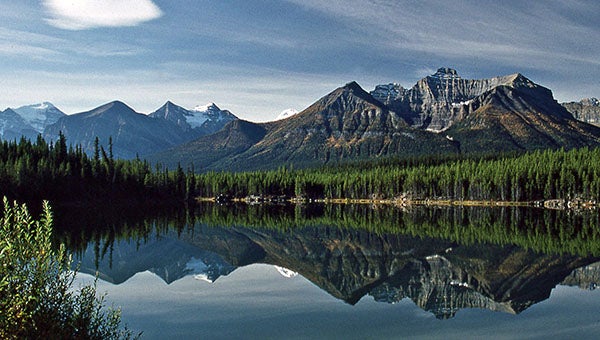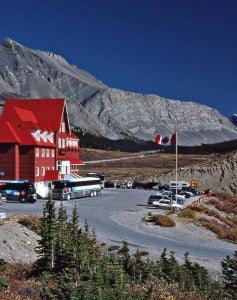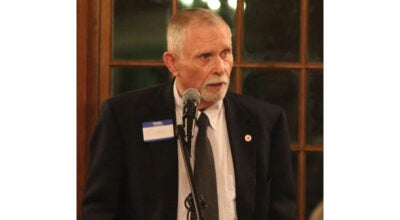North to Jasper National Park
Published 12:22 pm Saturday, July 2, 2016
by James D. Howell
ALBERTA, CANADA
We’re headed to Jasper, at the northern end of the Icefields Parkway; it’ll be an all-day excursion to get there from Banff, Canada. The day is clear and forecast to remain so for a few days. We’ll spend two nights in Jasper, enjoying a full day to explore on the far side.
Early morning in the Bow River valley is always a treat. Today we decide to take the old road (Bow Valley Parkway) for a change of perspective. The day will be a relaxed drive as much as possible, with time-outs for stopping and enjoying the view.
Just before Castle Junction we see the “Chamber of Commerce” elk on the right side of the road. A small herd is sheltered in the close by trees. We stop. The bull elk does not run off. He’s obviously here to fulfill his obligation to be photographed. It’s also rutting season and he may just be a little out of his mind trying to protect his harem. He poses; I click the shutter. He moves back to the trees; we move on.
At Lake Louise, we move back to the main road north; it’s named the Icefields Parkway. This route will take us by the Athabasca Glacier, but we’ll save that tour for another day. Today it’s Jasper.
From Lake Louise the character of the road changes. The valley narrows somewhat and the road is closer to lakes in flatter places. It’s well maintained and open to views of mountains, blue sky, golden aspen leaves and rushing water. It’s a visual glut. A series of large lakes, Hector, Bow and Peyto, anchor the valley to the west. We make a side trip to the famed Peyto. A parking area and a short trail lead to an overlook of the turquoise waters that have appeared in innumerable movies, commercials and tourist cameras.
On this day, the lower views of reflecting waters are more memorable; we stop several times to walk, take pictures and enjoy the clear, cool air. Aspen gold paints mountainsides under brilliant, clear blue skies. We cross the Saskatchewan River with its wide valley.
We make the grade-climbing turns to the upper elevations approaching the Columbia Ice fields. Near the top is a large parking/visiting area, carved from the mountainside. It has spectacular overlooks back down the valley, restrooms for creature comforts and a large walking display description of the mountain range.
Along the inside walkways, native artists display their wares for sale. It looks like a brisk business on this beautiful day.
We depart; the road flattens somewhat as we slip into the wide valley exit for the Athabasca Glacier. There’s a large welcome center with lots of room for tour buses. This center is the base of operations for the Brewster Company’s famous glacier tours. A large, custom-made vehicle takes patrons out to the Athabasca Glacier itself and guides conduct short walks on the top. It’ll have to be another day for us.
We stop for a quick view and continue toward Jasper. From here the road is close by the Athabasca River, with it’s very wide, flat, rocky flood plain. Snowmelt pushes rocks around with ease and the landscape this year is likely to be different the next. Mountains on either side sport their fall colors and we stop many times and enjoy the view.
Late in the day, we make the side road trip to Sumwapta Falls. The sun has moved behind the mountains and shadows are dark. There just isn’t enough light for pictures this late. The sound and fall of massive amounts of water moving among and over rocks is impressive, however, and we make a mental note to try to stop in on our way back to Banff. We sometimes have to change our itinerary to match local conditions.
Our night’s lodging is recommended to us by friends who came this way a couple of years ago. It’s about a mile before the town proper and is directly on the banks of the Athabasca River. A couple of kayakers are practicing on a small rivulet just by the restaurant/check in office. They’re fascinating to watch, twisting to maintain position in the river backwaters. All the water flows here; when you cast of into the river proper, there’s no easy way out for some distance.
We settle in, check out some brochures and decide to make the trip to Maligne Lake and Miette Hot Springs tomorrow. The distance is something of a stretch, but we think it’s doable. A dip in the natural mineral springs is appealing.
It’s a sleep-good night.
JAMES D. “ARCHIE” HOWELL is a Southampton County native and 1955 graduate of Franklin High School. He can be reached at archiepix@kingwoodcable.com.
- Aspen gold and granite in Jasper National Park
- Golden Aspen and clear blue Canadian sky
- Icefields Parkway in Jasper National Park
- View from the switchbacks overlook











